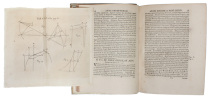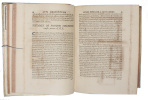4 books for « bernoulli jakob »Edit
-
Century
17th (3)
20th (1)
-
Topics
Leibniz (3)
Mathematics (1)
Tea (1)
"LEIBNIZ (LEIBNITZ), G.F. - JOHANN BERNOULLI - JAKOB BERNOUILLI. - CHRISTIAAN HUYGENS ET AL. - INTRODUCING THE LEMNISCATE CURVE.
Reference : 41704
(1694)
1. Nova Calculi Differentialis. Applicatio & usus, ad multiplicem linearum constructionem, ex data tangentium conditione. 2. Constructio Propria Problematiis de Curva Isochrona Paracentrica....& de constructione linearum transcendentium, una maxima ge...
Leipzig, Grosse & Gleditsch, 1694. 4to. Contemp. full vellum. Faint handwritten title on spine. a small stamp on titlepage. In: ""Acta Eruditorum Anno MDCXCIV"". (2),518 pp.. and 11 folded engraved plates. As usual with various browning to leaves and plates. The entire volume offered. Leibniz's papers: pp. 311-316, pp. 364-375. - Johann Bernoulli's papers: pp. 200-206, pp. 394-99, pp. 435-437, pp. 437-441. - Huygen's papers: pp. 338, pp. 339-41. - Jakob Bernoulli's papers: pp. 262-276, pp. 276-280, pp. 336-338, pp. 391-400. Some mispaginations.
All papers first appearance, dealing with, and clarifying the problems and the new applications of Leibniz' inventions of the differential- and integral calculus.In the papers Leibniz shows how to reduce linear first order ordinary differential equations to quadratures. I the other paper he gives a general method of finding the envelope of a family of curves, which helped to spread the theory of plane curves.In the groundbreaking paper offered here, Jakob Bernoulli introduces THE LEMNISCATE, a symmetric self-intersecting curve resembling a figure eight and defined by the condition that the product of the distance of anay point on the curve from two fixed points is (d/2)2, where d is the distance between the fixed points.""Jacob Bernoulli was fascinated by curves and the calculus, and one curve bears his name - the ""lemniscate of Bernoulli"", given by the polar equation r2=a cos 2""0"". The curve was described in the Acta Eruditorum of 1694 as resembling a figure eight or a knotted ribbon (lemniscus). However the curve that most caught his fancy was the logarithmic spiral....he swowed that it had several strioking properties not noted before...it is easy to appreciate the feeling that led Bernoulli to request that the ""spira mirabils"" be engraved on his tombstone together with the inscription ""Eadem mutata resurgo"" (Though changed, I arise again the same)."" (Boyer in his History of Mathematics).
"LEIBNIZ, GOTTFRIED & JOHANN BERNOULLI & JAKOB BERNOULLI & EHRENFRIED WALTHER VON TSCHIRNHAUS.
Reference : 42863
(1696)
Supplementum defectus geometria Cartesianae circa inventionem locorum. [Joh. Bernoulli] + [Two other papers]. Notatiuncula ad acta decemb. 1695. [LEIBNIZ]. - [THE BRACHISTOCHRONE PROBLEM]
Leipzig, Grosse & Gleditsch, 1696. 4to. Entire volume present. Nice contemporary full vellum. Small yellow paper label pasted to top of spine and library-label to front free end-papers. Internally some browning and brownspotting. Overall a nice and tight copy. [Bernoulli paper:] pp. 264-69. [Leibniz-paper:] pp. 45-47. [Entire volume: (2), 603, (1) pp. + plates].
First printing of the famous 1696-edition of Acta Eruditorum in which Johann Bernoulli published a challenge to the best mathematicians:""Let two points A and B be given in a vertical plane. To find the curve that a point M, moving on a path AMB , must follow such that, starting from A, it reaches B in the shortest time under its own gravity.""Johann adds that this curve is not a straight line, but a curve well known to geometers, and that he will indicate that curve, if nobody would do so that year. Later that year Johann corresponded directly with Leibniz regarding his challenge. Leibniz solved the problem the same day he received notice of it, and almost correctly predicted a total of only five solutions: from the two Bernoullis, himself, L'Hospital, and Newton. Leibniz was convinced that the problem could only be solved by a mathematician who mastered the new field of calculus. (Galileo had formulated and given an incorrect solution to the problem in his Dialogo). But by the end of the year Johann had still not received any other solutions. However, Leibniz convinced Johann that he should extend the deadline to Easter and that he should republish the problem. Johann now had copies of the problem sent to Journal des sçavans, the Philosophical Transactions, and directly to Newton. Earlier that year Johann had accused Newton for having filched from Leibniz' papers. Manifestly, both Johann and Leibniz interpreted the silence from June to December as a demonstration that the problem had baffled Newton. They intended now to demonstrate their superiority publicly. But Newton sent a letter dated Jan. 30 1697 to Charles Montague, then president of the Royal Society, in which he gave his solution and mentioned that he had solved it the same day that he received it. Montague had Newton's solution published anonymously in the Philosophical Transactions. However, when Bernoulli saw this solution he realized from the authority which it displayed that it could only have come from Newton (Bernoulli later remarked that he 'recognized the lion by its claw'). The present volume contains the following articles of interest:Jakob Bernoulli: 1, Observatiuncula ad ea quaenupero mense novembri de Dimensionibus Curvarum leguntur.2, Constructio Generalis omnium Curvarum transcendentium ope simplicioris Tractoriae et Logarithmicae.3, Problema Beaunianum universalius conceptum.4, Complanatio Superficierum Conoidicarum et Sphaeroidicarum.Johann Bernoulli5, Demonstratio Analyticea et Syntetica fuae Constructionis Curvae Beaunianae.6, Tetragonismus universalis Figurarum Curvilinearum per Construitionem Geometricam continuo appropinquantem.Tschirnhaus7, Intimatio singularis novaeque emendationis Artis Vitriariae.8, Responsio ad Observationes Dnn. Bernoulliorum, quae in Act. Erud. Mense Junio continentur.9, Additio ad Intimationem de emendatione artis vitriariae.
Die Werke...Band 3 (enthält seine Schriften zur Wahrscheinlichkeitslehre und Statistik sowie Beilagen zum diesem Problemkreis etc.). Hrsg. von der Naturforschenden Gesellschaft in Basel.
Basel, Birkhäuser Verlag, 1975. Small 4to. Orig. full cloth with dustjacket X,585 pp.
De Lineis Opticis, et alia" Excerpta ex literis ad--- (+) Schediasma de Resistentia Medii, & Motu projectorum gravium in medio resistente. (+) Tentamen de Motuum Coelestium causis. (+) De Linea Isochrona, in qua grave sine acceleratione descendit, & d... - [THE WAR OF THE GIANTS NEWTON AND LEIBNIZ ON THE WORLD SYSTEM]
Leipzig, Grosse & Gleditsch, 1689. 4to. Contemporary full vellum. Faint hand-written title to spine. A small stamp on title-page. In: ""Acta Eruditorum Anno MDCLXXXIX"". (8), 653, (7) pp. and 15 engraved plates. As usual with various browning to leaves and plates. The entire volume offered. Leibniz's papers: pp. 36-38 a. 1 engraved plate" pp. 38-46 pp. 82-89 a. 1 engraved plate" pp. 195-198.
First printing of these extremely important papers, in which Leibniz claimed that he independently of Newton had discovered the principal propositions of his ""Principia"" and which present us with Leibniz's fundamental physico-mathematical theory, his dynamics, his concepts of force, space and time. The ""Tentamen..."" constitutes Leibniz's response to Newton's theories about the motion of the celestial bodies. Leibniz can be said to have anticipated the modern mathematical principle of relativity, as it is his idea of individual co-ordinate systems and his practical rejection of the Galilean co-ordinate system that Newton adopted. Leibniz opposes Newton's ideas of attractions (gravitational forces) and calls them ""occult qualities"". The task of the ""Tentamen..."" was to attain a theory mathematically equivalent to Newton's in accounting for planetary motion and especially for the inverse-square law of Kepler's laws, but physically sound and capable of explaining the causes of phenomena.Newton attacked Leibniz's claim of priority in his anonymously published paper ""Commercium epistolicum"" (Phil. Transactions 1714), and states that ""in those tracts the principal propositions of that book are composed in a new manner, and claimed by Mr. Leibniz as if he had found them himself before the publishing of the said book. But Mr. Leibniz cannot be a witness in his own cause. It lies upon him either to prove that he had found them before mr. Newton, or to quit his claim."" The features of Leibniz's mathematical representation of motion as put forward in ""Tentamen..."" are, (see D.B. Meli: Equivalence and Priority. Newton versus Leibniz. pp. 90-91):- Empty space does not exist. The world is filled with a variety of fluids which are responsible for physical actions, including gravity.- Living force and its conservation are the fundamental notion and principle respectively, in the investigation of nature, however, they do not figure prominently in the study of planetary motion.- Finite and infinitesimal variables are regularly employed in the study of motion and of other physical phenomena. Living force and velocity are finite" solicitation and conatus are infinitesimal.- Accelerated motion, whether rectilinear or curvilinear, is represented as a series of infinitesimal uniform rectilinear motions interrupted by impulses. I call this 'polygonal representation'. Usually the polygon is chosen in such a way that each side is traversed in an equal element of time dt. In polygonal representations accelerations are reduced to a macroscopic phenomenon.- Propositions are often used to safeguard dimensional homogeneity. Constant factors - such as numerical factors, mass, and the element of time - are usually ignored in the calculations.Denys Papin's papers:1. Descriptio Torcularis, cujus in Actis Anni 1688 pag. 646 mentio facta a suit... and 1 plate. Pp. 96-101.2. De Gravitatis Causa et proprietatibus Observationes. Pp. 183-188.3. Examen Machinæ Dn. Perrault. Pp. 189-195 a. 1 plate.4. Rotatilis Suctor et Pressor Hasciacus, in Serenissima Aula Cassellana demonstratus & detectus. Pp. 317-322 a. 1 plate.5. In J.B. Appendicem Illam Ad Perpetuum Mobile, Actis Novemb.A. 1688 p. 592...Pp. 322-324 a. 1 plate.6. Excerpta et Litteris Dn. Dion Papini ad --- de Instrumentis ad flammam sub aqua conservandam. Pp. 485-489 a. 1 plate.With the paper describing and depicting Papin's famous invention of the CENTRIFUGAL PUMP. ( Rotatilis Suctor et Pressor Hasciacus, in Serenissima Aula Cassellana demonstratus & detectus. - The paper offered (no.4).Jakob Bernoulli's papers:1. De Invenienda Cujusque Plani Declinatione, ex unica observatione projectæ a flylo umbræ. Pp. 311-316 a. 1 plate.2. Vera Constructio geometrica Problematum Solidorum & Hypersolidorum, per rectas lineas & circulos. Pp. 586-588 a. 1 plate.3. Novum Theorema Pro Doctrina Sectionum Conicarum. Pp. 586-588 a. 1 engraved plate.
 Write to the booksellers
Write to the booksellers




